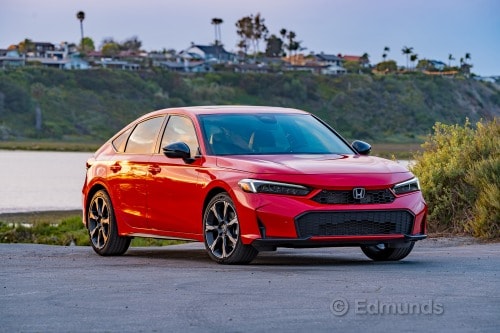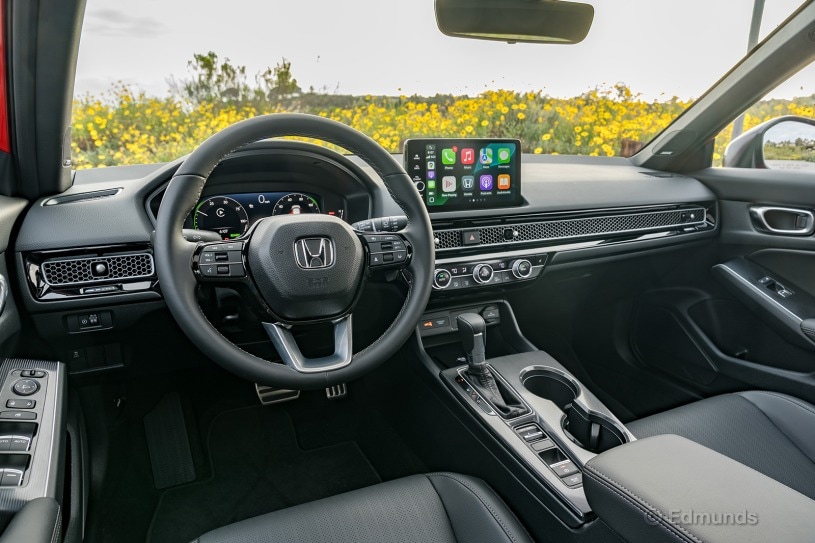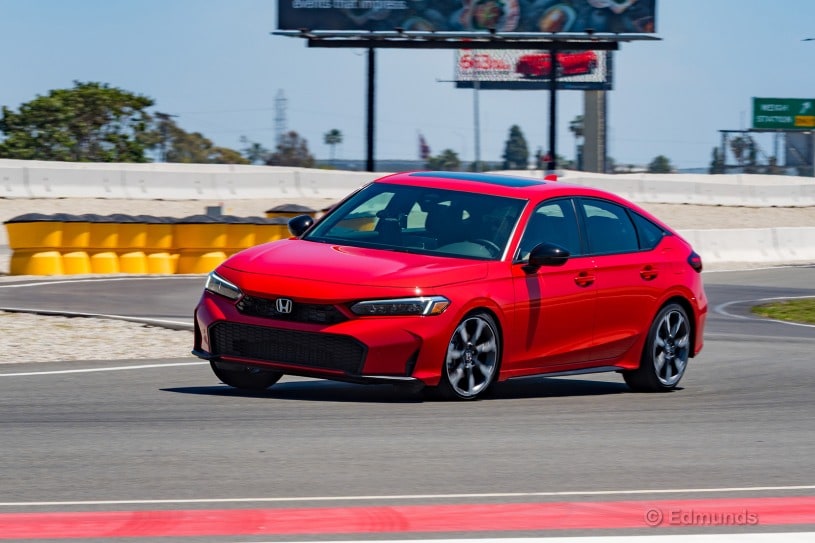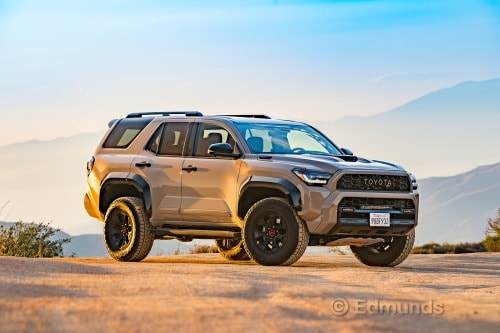2025 Honda Civic Hybrid: What’s It Like to Live With?
We’ll be spending one year and 20,000 miles with Honda’s compact hybrid
What We Got And Why
by Steven Ewing, Director, Editorial Content
• Our test vehicle: 2025 Honda Civic Hybrid Sport Touring Hatchback
• Base MSRP: $34,300
• MSRP as tested: $34,300

| Miles Driven | Average MPG |
| 6,173 | 35.5 |
Latest Highlights
- The Honda Civic Hybrid was named Edmunds Top Rated Car and Best of the Best for 2025.
- We’re spending a year with a fully loaded Civic Hybrid Sport Touring hatchback.
- The EPA estimates we should see 48 mpg combined.
- The Sport Touring features Google Built-In tech and an advanced suite of driving aids.
What do you want to know about?
We love the new Honda Civic. Not only was it named Edmunds Top Rated Car for 2025, it also won our prestigious Best of the Best award — the standout pick across all our Top Rated categories. With accolades like that, we knew we had to get a Civic in for long-haul testing. Meet the 2025 Honda Civic Hybrid hatchback that just arrived in our One-Year Road Test fleet.

What did we get?
Honda only offers the hybrid powertrain on the Civic Sport and Civic Sport Touring, and as we discussed in our recent buying guide, we firmly believe that the more expensive Sport Touring trim is the way to go. This model gets you niceties like heated leather seats and a full suite of driver assistance features, but crucially, also upgrades the tech to a 9-inch touchscreen running the Google Built-In suite of apps.
You can get hybrid power in both the Civic sedan and hatchback, and we opted for the latter. It’s more functional and better-looking, and it makes the Civic a compelling alternative for a higher-riding compact SUV.
The Civic Sport hatchback starts at $28,600 including a $1,150 destination charge, and the Sport Hybrid comes in at $32,300. Our Sport Touring costs $34,300.

Testing time
The Civic’s hybrid system combines a 2.0-liter four-cylinder engine with two electric motors, and total output is a healthy 200 horsepower and 232 lb-ft of torque. That’s more power than what you get in the sporty Civic Si.
At the Edmunds test track, our Civic Sport Touring Hybrid accelerated from 0 to 60 mph in 7.5 seconds, and ran through the quarter mile in 15.7 seconds at 87.8 mph. Interestingly, the hybrid is 0.2 second quicker than the last Civic Si we tested, though the Si was able to complete the quarter mile 0.2 second quicker, and at a faster trap speed, too (91.5 mph). This largely comes down to the fact that the Civic Si rides on stickier summer tires as opposed to the all-season rubber on our hybrid hatch.
This disparity really shows on our 200-foot skidpad, where the Civic Si pulled 0.99 g of lateral grip, compared to the hybrid hatch’s 0.85 g. The Civic Si was more sure-footed under braking, too, with panic stops from 60 mph taking 106 feet, while the Sport Touring Hybrid hatch did the same deed in 131 feet.

All that said, we love the way our Civic hybrid drives. “The Civic Hybrid is spacious, comfy and zippy,” says executive director of written content Jodi Tourkow. “I was able to move around on the highway with ease, and acceleration wasn’t a problem.”
Our fuel economy’s been great right off the bat, too. The EPA rates our car at 50 mpg city, 45 mpg highway and 48 mpg combined — numbers that are super easy to hit. We’re also looking forward to putting the EPA’s bladder-busting 595-mile range figure to the test on long trips.

What do we think so far?
“This is such a pleasant car,” vehicle test editor Reese Counts writes in our logbook. “It’s not fancy or luxurious, but it’s such a nice vehicle to drive every day. It’s comfortable, quiet, and easy to see out of. The powertrain is smooth and reasonably powerful for a hybrid, and you don’t have to work hard to get great fuel economy. The hatch makes it super practical too. It’s hard to fault the Civic Hybrid as a daily driver.”
Exactly how practical is the hatch, though? Senior reviews editor Brian Wong says, “The hatchback doesn’t offer as much extra storage as you might think. On paper there’s a giant disparity between it and the sedan (24.5 vs 14.8 cubic feet) in terms of trunk space, but in practice I was only able to fit one more small carry-on bag into the hatchback because it’s kind of oddly shaped. The advantage it offers is the ability to fold the seats down, and the hatch’s giant opening allows you to load larger items that won’t fit in the sedan (like an office chair).”

Parents with young children take note: “The rear seat-belt buckles are set a little narrow,” notes video manager Will Kaufman. “What I mean is, if you’ve got a kid buckling into a booster seat, the buckle winds up right at the edge of the booster. That makes it a tiny bit harder to reach and buckle up, which can be frustrating for, say, younger kids who recently learned to buckle up and really, really want to do it themselves every time.”
Overall, we’re impressed with the Civic so far; Tourkow describes this hybrid hatchback as “an all-around good buy.” Here’s hoping we continue to feel this way once the honeymoon phase is over.
Honda loaned Edmunds this vehicle for the purpose of evaluation.
2025 Honda Civic Hybrid: Real-World Fuel Economy
How’s the fuel economy been relative to expectations? Sum it up.
Average lifetime mpg: 35.5
EPA mpg rating: 48 combined (50 city/45 highway)
Best fill mpg: 46.8
Best range (miles): 157.2
Current odometer: 1,078
2025 Toyota 4Runner: What’s It Like to Live With?
We’re going to spend a year with the Toyota 4Runner to see if it can capture our hearts and minds

| Miles Driven | Average MPG |
| 3,179 | 18.5 |
Latest Highlights
- We bought a 2025 Toyota 4Runner.
- It kicks off the sixth generation of the venerable SUV.
- It’s a definite improvement over the previous generation.
- But is that enough?
What do you want to know about?
What We Got And Why
by Ryan Greger, Social Media Content Strategist
• Our test vehicle: 2025 Toyota 4Runner
Let’s be real: The outgoing Toyota 4Runner was very, very dated. The fifth-generation 4Runner went on sale in 2010, and it soldiered on with only minor updates for 15 years. For 2025, though, the sixth-generation 4Runner arrived, promising a host of updates aimed at making the rig both more refined on-road and more capable off-road. Was Toyota successful in that mission? We have the next year to find out.
We just bought this 2025 4Runner TRD Pro to add to the Edmunds One-Year Road Test fleet. Over the next year and many thousands of miles, we’ll be putting Toyota’s best off-roader through its paces — in fact, it’s already faced off against its more luxurious cousin, the Lexus GX, in an off-road comparison test.
Edmunds bought this vehicle for evaluation purposes.
2025 Toyota 4Runner: Real-World Fuel Economy
This is a big-ole trucky SUV. Merely so-so fuel economy would be a victory.
Average lifetime mpg: 18.5
EPA mpg rating: 23 combined (23 city/24 highway)
Best fill mpg: 21.0
Best range (miles): 297.7
Current odometer: 3,179
2025 Toyota 4Runner: Comfort
How comfortable is the all-new 4Runner?
All that performance comes at a cost
“There’s an obvious cool factor to the 4Runner TRD Pro: The lifted suspension and knobby tires come together with this generation’s aggressive styling to form a truly mean-looking rig. However, I imagine they also contribute to the harsh ride and rather unwieldy handling. This is not a vehicle I would ever consider daily driving, personally.” — Ryan Greger, social media content strategist
2025 Toyota 4Runner: Technology
How’s the 4Runner’s technology?
A small, but not insignificant annoyance
“This is a pretty minor qualm, but it gets annoying. On most vehicles I’ve been in that have surround-view cameras, the camera display stays on for a few moments after shifting the vehicle out of reverse and into drive. This can be super helpful when making three-point turns or when maneuvering in tighter spaces, which can require shifting back and forth between drive and reverse. However, the 4Runner immediately turns off the camera display upon being shifted into drive, requiring you to press a button on the center console should you want to activate it again. It may sound nitpicky, but I encountered this situation multiple times over the course of a weekend, and it starts to get frustrating quickly.” — Ryan Greger, social media content strategist
2025 Subaru Forester Hybrid: What’s It Like to Live With?
We got a 2025 Subaru Forester Hybrid to see how it compares to its gas-only sibling over a one-year test

| Miles Driven: | Average MPG: |
| 4,455 | 26.8 |
Latest Highlights
- We got a 2025 Subaru Forester Hybrid.
- In Edmunds’ testing, we favored the hybrid over the gas-only version.
- Let’s see if that holds up after completing our One-Year Road Test.
What do you want to know about?
What We Got And Why
by Keith Buglewicz, managing editor
• Our test vehicle: 2025 Subaru Forester Hybrid
Subaru was early to the compact SUV game with the first Forester, which came out for the 1997 model year. Fast-forward nearly 30 years and Subaru is on its sixth Forester — and with a new hybrid engine no less. Sounds like a good reason to add a 2025 Subaru Forester Hybrid to our One-Year Road Test fleet.
The Forester cut its teeth off-road, and it has earned a reputation for being heavy on the “utility” side of the sport-utility equation. For years, the Forester basically owned the idea of having actual off-road chops for its compact crossover SUV, and Subaru leaned into that with each successive generation.
So what makes the sixth-generation Forester different? A new hybrid engine for starters, one that promises truly excellent fuel economy without compromising what makes the Forester such a popular pick for the camping crowd. It also has refreshed styling and an updated interior with one of the largest touchscreens in the class. All of which got us curious enough to add one to our One-Year Road Test fleet.
What did we get?
Our test vehicle is a 2025 Forester Limited Hybrid, which is on the nicey-nice end of the trim ladder, topped only by the Touring Hybrid. Our Forester is painted in Autumn Green Metallic, aka “that green color Subarus always seem to be.” All-wheel drive is standard, with modes that enhance traction on various terrains like mud and snow. The Forester rides on 18-inch alloy wheels 8.7 inches above the ground, which is pretty up there for this class of SUVs. Inside, the Limited comes with black heated leather seats, a Harman/Kardon audio system, an 11.6-inch touchscreen, standard EyeSight advanced driver assist systems, and a set of $156 dealer-installed rubber floor mats. Aside from the floor mats there are no other options, so the total price comes out to $42,586, including the $1,420 destination charge.
While Edmunds often purchases vehicles for the One-Year Road Test fleet, Subaru loaned this Forester Hybrid to us for the purposes of evaluation.
Under the hood is Subaru’s new hybrid system, and it’s a darn sight better than the old one that quietly disappeared from the Crosstrek a few years ago. This one puts out a combined 194 horsepower, 14 more hp than the standard gas engine, and routes its power to all four wheels through a continuously variable automatic transmission. At our test track, a similar Forester Hybrid took 8.8 seconds to get to 60 mph from a standstill. That’s on the slow side for the class and notably pokey compared to the Honda CR-V hybrid (8.0 seconds) and the Toyota RAV4 Hybrid (7.8 seconds). On the flip side, the EPA says the Forester should get 35 mpg in mixed driving, which … also trails both the Honda and the Toyota by 2 mpg and 4 mpg, respectively.
If you’re wondering why we didn’t get the off-roady Wilderness trim, it’s because the 2025 version is still based on the previous-generation Forester. Why not wait? Well, when the new version goes on sale it won’t be available with the hybrid engine, and the hybrid is one of the main reasons we wanted to check out the new Forester in the first place.
Why did we get it?
This isn’t Subaru’s first hybrid; that was way back in 2014 with the XV Crosstrek. But that hybrid didn’t really save much in the way of gas, adding a mere 2 mpg but costing considerably more. Our Limited Hybrid costs about $1,700 more than a similar non-hybrid Limited, but it promises a 6 mpg improvement in combined fuel economy and 9 mpg in the city. That’s nothing to sneeze at, and we wonder if those claims will bear out over time.
Then there’s the touchscreen. We noted in our First Drive review that it’s laggy, something it shares with other Subarus with the same system. However, that same review noted that when using smartphone integration like Apple CarPlay, it’s not so bad. Over the year, we’ll find out if it’s a nonissue or if it drives us crazy.
Finally, there are a lot of outdoorsy types on staff here, and Subaru’s no longer the only compact SUV with off-road aspirations. Over the next 12 months and 20,000 miles, we’re going to put the Forester’s off-road capabilities to the test and see if they’re enhanced or hindered by the hybrid drivetrain.
2025 Subaru Forester Hybrid: Real-World Fuel Economy
This is a hybrid, so we’ll be keeping a close eye on its fuel economy
Average lifetime mpg: 26.8
EPA mpg rating: 35 combined (35 city/34 highway)
Best fill mpg: 27.6
Best range (miles): 272.7
Current odometer: 4,455



